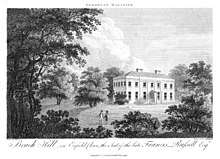Hadley Wood
Hadley Wood is a suburb in the north of Greater London, close to the border with Hertfordshire. It is located in the London Borough of Enfield, about 11 miles (17.7 km) north north-west of Charing Cross and is situated close to Barnet.


History
Hadley Wood sits just East of the village of Monken Hadley (which is now a suburb of Barnet), with the two settlements sharing several features of social life. However, in modern history the two communities are distinct and separate, belonging to different parishes (both civil and ecclesiastical) which in turn belong to different civil Boroughs and ecclesiastical Deaneries.
Hadley Wood has always possessed a strong historical link with the suburb of Cockfosters. In civil administration, Hadley Wood was part of the Municipal Borough of Enfield since its foundation in 1850 all the way up until 1965. Hadley Wood became part of the newly created Ward of Hadley Wood and Cockfosters in 1909 to allow for the return of local councillors. In 1965 the Municipal Borough was abolished, and the London Borough of Enfield formed. The Ward of Hadley Wood and Cockfosters, whilst covering the same geographical area, is now known simply as the Ward of Cockfosters.[2]
In ecclesiastical administration, Hadley Wood remains part of the parish of Cockfosters and the Deanery of Enfield.[3] However, in 1911 a small local church (technically a 'proprietary chapel') dedicated to St Paul was opened on Camlet Way, Hadley Wood. Although it has not achieved the status of a parish church, it now operates independently of Cockfosters parish church with its own staff and administration.
The large, four-platform railway station at Hadley Wood seems somewhat out of proportion to the size of the community; local folklore suggests that the station was enlarged at the behest of local resident Sir Nigel Gresley, the Chief Mechanical Engineer of the London and North Eastern Railway who lived in Hadley Wood during the 1920s and 1930s before moving away to near St Albans.[4] Yet, there seems to be little or no evidence to support the theory.
Education
- Hadley Wood School is a primary school administered by the London Borough of Enfield.[5]
- There is a Church of England Primary School in the neighbouring community of Monken Hadley, administered by the London Borough of Barnet.
- A private Roman Catholic secondary school, St Martha's Convent School, takes female students from the ages of 11-18 and is located in nearby Monken Hadley.
Transport
- Hadley Wood railway station is at the junction of Crescent East and Crescent West in the centre of Hadley Wood. It is operated by Great Northern.
- There is no Underground station in Hadley Wood. The closest are Cockfosters (Piccadilly line) and High Barnet (Northern line).
- London Buses routes 298 and 399 serve Hadley Wood.
See also
- Beech Hill Park, a grade II listed building off Beech Hill, that is today used as the club house of Hadley Wood Golf Course.
- Charles Jack, farmer and landowner who was primarily responsible for the construction of Hadley Wood.
- Albert Kingwell, long-serving estate manager at Hadley Wood.
References
- Clark, Nancy. (1978) Hadley Wood: Its background and development. 2nd revised edition. p. 65.
- Ward boundaries indicated on the website Archived 13 May 2013 at the Wayback Machine of the Borough Council.
- Ecclesiastical details listed at Crockford Clerical Directory.
- The Hadley Wood residence is cited in this Archived 27 July 2013 at the Wayback Machine biography.
- Hadley Wood School
Further reading
- Clark, Nancy. (1968) Hadley Wood: Its background and development. (2nd revised edition 1978).

